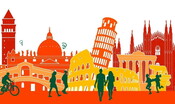The FAI Autumn Days return on Saturday 12 and Sunday 13 October with the 13th edition: there will be 700 places of art, history and nature, unusual and curious, little known and appreciated – some of which are usually inaccessible – which will open to the public in 360 Italian cities, thanks to thousands of FAI volunteers active in each region. “The beauty, the strength, the originality of the FAI Autumn Days consists precisely in the extraordinary and unexpected variety of choices, in the ever-renewing surprise of what our territorial network identifies for the openings – declared the FAI president Marco Magnifico – and above all this ‘beauty’ lies in the imagination of a group of civil and energetic Italians who put themselves at the service of the common heritage through FAI. This is the deepest meaning of the thirteenth edition of the FAI Days: a great one a sign of optimism, of vigor, of civil brotherhood of many citizens, delegates, volunteers and ‘Apprentice Ciceroni’, for their fellow citizens”. The Autumn FAI Days will see a special participation of young FAI volunteers.
Suggestions on what to see
- A Roma we will exceptionally visit Palazzo Sciarra, headquarters of the Rome Foundation, with its majestic and richly decorated rooms, from the Cardinal’s Library, designed by Luigi Vanvitelli, to the Cabinet of Mirrors. It will also be possible to admire one of the most beautiful views of Rome from the small courtyard hidden behind the monumental Acqua Paola Fountain, and, remaining on the Janiculum, you will also be able to discover the Bosco Parrasio (entrance reserved for FAI members) and the American Academy in Rome.
- A Milanohowever, you will be able to visit exclusively Palazzo Melzi d’Eril, home of the Cariplo Foundation, with its art collection – from Tiepolo to the preparatory cartoons by Achille Funi for the decoration of Ca’ de Sass – and the majestic staircase of honor, and Palazzo Cusani, usually closed as it is the headquarters of the Lombardy Army Military Command, as well as the NATO representative office in Milan. The Bovisa Campus of the Polytechnic will also open in via La Masa, which houses the School of Industrial and Information Engineering. In Lombardy Valverde Castle can be visited, overlooking the Upper Town in Bergamo.
- A Torino i visitors will be able to get to know Villa d’Aglie’, on the hill, while in the center Palazzo Graneri Della Roccia will open, home to the Circolo dei Lettori and one of the most sumptuous noble palaces in the city, with the recently restored mid-eighteenth century Chinese cabinet. TO Susainstead, the bell towers of San Giusto and Santa Maria Maggiore will be exclusively discovered (for the latter entrance reserved for FAI members).
- A Napoli you will be able to get to know Palazzo San Giacomo, the municipal building renovated in the 1930s based on a design by Marcello Piacentini, and you will also be able to access a space never seen before in ‘underground Naples’, the Hypogeum in Piazza del Plebiscito, six meters below the Basilica of San Francesco di Paola.
- A Bolognathen, exceptionally, Palazzo Grassi will open, home to the Officers’ Club and usually inaccessible to the public, among the few surviving testimonies of the medieval urban layout, while in Modena will be reserved for members. Visit the Collegio dei Nobili di San Carlo.
- A Palermo It will be possible to visit the headquarters of the Order of Architects of the Province, inside the former Palazzo Florio, where the private apartment of the Minnella family will open for members only. TO Messinainstead, it will be possible to enter the headquarters of the Gazzetta del Sud. In Genoa, however, the Hydrographic Institute of the Navy will open, inside Forte San Giorgio, in Perugia the Oratorio San Francesco dei Nobili, often closed to the public and Bari will be able to visit the Bank of Italy, one of the most monumental buildings in the city.
Other special places
Among the “gems” kept in small municipalities open for the FAI Autumn Days, we highlight Uzzano (Pistoia)the Villa del Castellaccio (entrance reserved for Fai members), where Giacomo Puccini wrote the second and third acts of Bohe’me, while a Grottole (Matera) the ‘Cassarmonica’ will be set up specifically for Fai, created a century ago to adorn the square and accommodate orchestral performances during religious festivals. Among the exceptional Venetian openings, Villa Forni Cerato in Montecchio Precalcino (Vicenza), one of the twenty-four Palladian villas included in the UNESCO list of World Heritage Sites. The Sanctuary of the Via Crucis will also be open to visitors Cerveno (Brescia)l’Acetaia Midolini a Manzano (Udine)the ‘Colombaia’, residence of Luchino Visconti in Forio, on the island of Ischiathe Convent of Renacavata a Camerino (Macerata), first monastery in the world of the Capuchin Order.
Among the villages they then stand out Tellaroperched on a cliff overlooking the Gulf of La Spezia, and Valmontonein the province of Rome, where you can visit Palazzo Doria Pamphilj. TO Sinalunga (Siena) Farnetella Castle and the village of the same name will open for the first time.
Many openings dedicated to sustainability and knowledge of nature and landscape will then be organised. TO Valva (Salerno)in a completely exceptional way, the public will visit the restoration site of the historic garden of Villa d’Ayala, while at Bassano del Grappa (Vicenza) visitors to the Santa Croce di Campese Complex will have the opportunity to visit the “brolo” or “garden of the simple”. TO Fara San Martino (Chieti) The Del Verde Aqueduct will be exceptionally open, on the slopes of the Maiella massif: the discovery of the evocative tunnels of the aqueduct will be an opportunity to talk about drought as an effect of climate change. TO Rieti you can explore the Lungo and Ripasottile Lakes Reserve, while in Basilicata you stop through the Candela Gorges in Rotondella (Matera).
